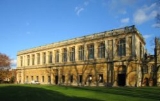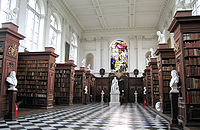
Wren Library, Cambridge
Encyclopedia

Trinity College, Cambridge
Trinity College is a constituent college of the University of Cambridge. Trinity has more members than any other college in Cambridge or Oxford, with around 700 undergraduates, 430 graduates, and over 170 Fellows...
in Cambridge
Cambridge
The city of Cambridge is a university town and the administrative centre of the county of Cambridgeshire, England. It lies in East Anglia about north of London. Cambridge is at the heart of the high-technology centre known as Silicon Fen – a play on Silicon Valley and the fens surrounding the...
. It was designed by Christopher Wren
Christopher Wren
Sir Christopher Wren FRS is one of the most highly acclaimed English architects in history.He used to be accorded responsibility for rebuilding 51 churches in the City of London after the Great Fire in 1666, including his masterpiece, St. Paul's Cathedral, on Ludgate Hill, completed in 1710...
in 1676 and completed in 1695.
The library is a single large room built over an open colonnade on the ground floor of Nevile's Court
Nevile's Court, Trinity College, Cambridge
Nevile's Court is a court in Trinity College, Cambridge, England, created by a bequest by the college's master, Thomas Nevile.The east side is dominated by the college's Hall, and the north and south sides house college rooms for fellows raised above the cloisters...
. The floor of the library proper within the upper storey lies several feet below the external division between the two storeys, reconciling the demands of use with the harmony of architectural proportion. It is credited as being one of the first libraries to be built with large windows to give comfortable light levels to aid readers.
The book stacks are arranged in rows perpendicular to the walls under the intervals between the windows. At the end of each stack is a fine limewood carving by Grinling Gibbons
Grinling Gibbons
Grinling Gibbons was an English sculptor and wood carver known for his work in England, including St Paul's Cathedral, Blenheim Palace and Hampton Court Palace. He was born and educated in Holland where his father was a merchant...
, and above these are plaster cast busts of notable writers through the ages. Other marble bust
Bust (sculpture)
A bust is a sculpted or cast representation of the upper part of the human figure, depicting a person's head and neck, as well as a variable portion of the chest and shoulders. The piece is normally supported by a plinth. These forms recreate the likeness of an individual...
s standing on plinths depict notable member of the college and are mostly carved by Louis-François Roubiliac
Louis-François Roubiliac
Louis-François Roubiliac was a French sculptor who worked in England, one of the four most prominent sculptors in London working in the rococo style, "probably the most accomplished sculptor ever to work in England", according to Margaret Whinney.-Works:Roubiliac was largely employed for portrait...
. A later addition is a full size statue of Lord Byron carved by Bertel Thorvaldsen
Bertel Thorvaldsen
Bertel Thorvaldsen was a Danish-Icelandic sculptor of international fame, who spent most of his life in Italy . Thorvaldsen was born in Copenhagen into a Danish/Icelandic family of humble means, and was accepted to the Royal Academy of Arts when he was eleven years old...
, originally offered to Westminster Abbey
Westminster Abbey
The Collegiate Church of St Peter at Westminster, popularly known as Westminster Abbey, is a large, mainly Gothic church, in the City of Westminster, London, United Kingdom, located just to the west of the Palace of Westminster. It is the traditional place of coronation and burial site for English,...
for inclusion in Poets' Corner
Poets' Corner
Poets' Corner is the name traditionally given to a section of the South Transept of Westminster Abbey because of the number of poets, playwrights, and writers buried and commemorated there. The most recent additions were a memorial floor stone unveiled in 2009 for the founders of the Royal Ballet...
, but refused due to the poet's reputation for immorality.

On the east balustrade of the library's roof are four statues by Gabriel Cibber
Caius Gabriel Cibber
Caius Gabriel Cibber was a Danish sculptor, who enjoyed great success in England, and was the father of the actor, author and poet laureate Colley Cibber. He was appointed "carver to the king's closet" by William III....
representing Divinity, Law, Physic (medicine), and Mathematics.
Notable books
The library contains many notable rare books and manuscripts, many bequeathed by past members of the college.Included in the collection are;
- Isaac NewtonIsaac NewtonSir Isaac Newton PRS was an English physicist, mathematician, astronomer, natural philosopher, alchemist, and theologian, who has been "considered by many to be the greatest and most influential scientist who ever lived."...
's first edition copy of Principia MathematicaPhilosophiae Naturalis Principia MathematicaPhilosophiæ Naturalis Principia Mathematica, Latin for "Mathematical Principles of Natural Philosophy", often referred to as simply the Principia, is a work in three books by Sir Isaac Newton, first published 5 July 1687. Newton also published two further editions, in 1713 and 1726...
with hand written notes for the second edition. - An eighth century copy of the Epistles of St PaulPauline epistlesThe Pauline epistles, Epistles of Paul, or Letters of Paul, are the thirteen New Testament books which have the name Paul as the first word, hence claiming authorship by Paul the Apostle. Among these letters are some of the earliest extant Christian documents...
- A. A. MilneA. A. MilneAlan Alexander Milne was an English author, best known for his books about the teddy bear Winnie-the-Pooh and for various children's poems. Milne was a noted writer, primarily as a playwright, before the huge success of Pooh overshadowed all his previous work.-Biography:A. A...
's manuscript of Winnie-the-PoohWinnie-the-PoohWinnie-the-Pooh, also called Pooh Bear, is a fictional anthropomorphic bear created by A. A. Milne. The first collection of stories about the character was the book Winnie-the-Pooh , and this was followed by The House at Pooh Corner...
and The House at Pooh CornerThe House at Pooh CornerThe House at Pooh Corner is the second volume of stories about Winnie-the-Pooh, written by A. A. Milne and illustrated by E. H. Shepard. It is notable for the introduction of the character Tigger, who went on to become a prominent figure in the Disney Winnie the Pooh franchise.- Plot :The title...
. - The Capell collection of early Shakespeare editions
- A collection of autograph poems by John MiltonJohn MiltonJohn Milton was an English poet, polemicist, a scholarly man of letters, and a civil servant for the Commonwealth of England under Oliver Cromwell...
- A 14th-century manuscript of The Vision of Piers Plowman
- Several works printed by William CaxtonWilliam CaxtonWilliam Caxton was an English merchant, diplomat, writer and printer. As far as is known, he was the first English person to work as a printer and the first to introduce a printing press into England...
, including the first book printed in English and the first dated printed book produced in England - Several notebooks written by Ludwig WittgensteinLudwig WittgensteinLudwig Josef Johann Wittgenstein was an Austrian philosopher who worked primarily in logic, the philosophy of mathematics, the philosophy of mind, and the philosophy of language. He was professor in philosophy at the University of Cambridge from 1939 until 1947...
- Handwritten notes by Robert OppenheimerRobert OppenheimerJulius Robert Oppenheimer was an American theoretical physicist and professor of physics at the University of California, Berkeley. Along with Enrico Fermi, he is often called the "father of the atomic bomb" for his role in the Manhattan Project, the World War II project that developed the first...
describing the "Trinity" atomic bomb testTrinity testTrinity was the code name of the first test of a nuclear weapon. This test was conducted by the United States Army on July 16, 1945, in the Jornada del Muerto desert about 35 miles southeast of Socorro, New Mexico, at the new White Sands Proving Ground, which incorporated the Alamogordo Bombing...
in New MexicoNew MexicoNew Mexico is a state located in the southwest and western regions of the United States. New Mexico is also usually considered one of the Mountain States. With a population density of 16 per square mile, New Mexico is the sixth-most sparsely inhabited U.S...
, U.S.United StatesThe United States of America is a federal constitutional republic comprising fifty states and a federal district... - Ramanujan's "lost notebookRamanujan's lost notebookSrinivasa Ramanujan's lost notebook is the manuscript in which Ramanujan, the great Indian mathematician from Cambridge University, recorded the mathematical discoveries of the last year of his life. It was rediscovered by George Andrews in 1976, in a box of effects of G. N. Watson stored at the...
" - 1620 edition of William Morgan's translationWilliam Morgan (Bible translator)William Morgan was Bishop of Llandaff and of St Asaph, and the translator of the first version of the whole Bible into Welsh from Greek and Hebrew.-Life:...
of the bible into Welsh
Visiting
The library is open to the public, but opening times are limited. There is no admission charge for the Wren Library, though there is a charge for entry to the rest of the college.External links
- Trinity College pages for the Wren Library

